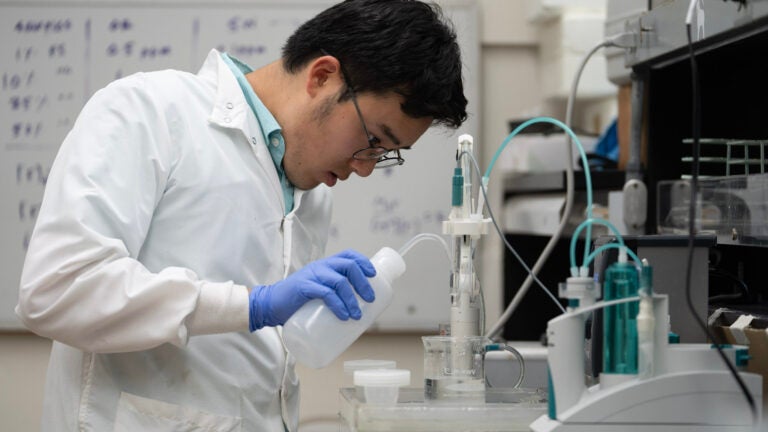
2023 REU student Isaac Xie replicated ocean processes in a laboratory setting to examine what happens when olivine sand mixes with ocean sediment. (Nick Neumman/WIES)
Sticking with oceanic carbon sequestration
Hi! I’m Isaac, a rising undergraduate senior with a concentration in environmental chemistry at Middlebury College. This summer, I had the opportunity to join Dr. William Berelson’s lab on the Wrigley Institute NSF REU program to embark on a project involving oceanic carbon sequestration.
I know, ‘oceanic carbon sequestration’ is a mouthful, but it means that the ocean acts as a storage for carbon. It is also a very important naturally-occurring phenomenon that regulates climate changes (without it, our planet would be closer to the searing conditions of Venus). Oceanic carbon sequestration plays a significant part in uptaking Earth’s atmospheric carbon—in fact, about 40% of all anthropogenic (human-induced) CO2 emissions have been uptaken by the ocean! As atmospheric CO2 parts continue to increase and the climate challenge becomes ever more imminent, if only there was a way to increase the ocean’s capacity to uptake CO2…
Enter olivine sand: a processed form of the very common mineral olivine. Studies have shown—in theory—that mixing olivine sand with ocean sediment (particularly at the coastal, shallow area called the continental shelf) can raise the alkalinity (basically the amount of negatively charged ions) of seawater, which in-turn increases the ocean’s capacity for carbon sequestration. But theory only takes you so far (Oppenheimer reference, also fact), and what I, working alongside Berelson lab PhD candidate Matthew Quinan, strove to determine was the practicality of mixing olivine sand to raise alkalinity.

To do so, we had to replicate the ocean…an impossible task because the ocean—and nature in general—is too complex for any lab to ever simulate perfectly, but we did so to an acceptable extent in boxes called flumes. After filling up both the sediment (varied by amount of olivine content) and overlying water layers (with fresh sediment and seawater collected from Venice Beach), we used pumps to induce flow of water similar to how seawater flows on the continental shelf. We then took samples of both the overlying water and water that penetrated into the sediment (porewater) to see how alkalinity changed over time.
Analyzing my data, it seems as though there was a lag in the olivine sands’ ability to increase alkalinity at the beginning of the experiments, but quickly increased the alkalinity of seawater as time progressed. Despite the eventual dramatic increases, alkalinity was increased differently from what we expected—we hypothesized that the alkalinity increase would happen drastically at first but taper off with time.
Thus, because of lingering uncertainties including why the alkalinity did not increase the way we expected it to, I unfortunately cannot affirm that olivine sand can be used for significant carbon sequestration projects. Nonetheless, this information is valuable to determine next steps that would likely eventually approve (or disprove) olivine sand’s use for carbon sequestration, and from that, I derive a sense of accomplishment! I would say, an overarching theme of my experience this summer was to trust—and stick with—the process. There were some very long days (~12 hours for the two Venice Beach sand collection days!), but not losing sight of the big-picture goal (and one with significant implications for humanity) was mainly what kept me going. In the grand scheme of things, this project was a piece of a large puzzle that has been the subject of ongoing research. So, Matt has been ‘sticking with it’ for much longer: doing so since before I came, during my time, and will continue for at least his PhD years.
As a rising senior now spending my last college summer, post-college plans have been very much on my mind. Coming to Wrigley this summer, I had the intention to get an experience of what being a PhD candidate is like and garner more interest in research. I would say that having spent so much time with Matt, I believe that I have a strong impression of what working towards your PhD can be like (Matt takes his work very seriously but certainly finds enjoyment in the lab). Although I could see myself taking up similar work and doing well with it, I cannot say that I am convinced becoming a PhD candidate or doing research is the immediate post-grad plan. I admit I have not yet experienced an ‘aha! This is my calling!’ moment, and I still have not really experienced anything other than academia so far—in other words, I’m still indecisive about my future.
No matter my career future though, one passion remains consistent: I want my career to be one sticking up for the environment—and for the people. I currently feel a balance between uncertainty and excitement for my future (though I can’t help but feel uncertainty ever more weighing as my graduation approaches), and I want to keep my paths open. In the meantime, I’ll tell myself that I’m doing great, that I’m doing my best, and to just keep ‘sticking with it’.